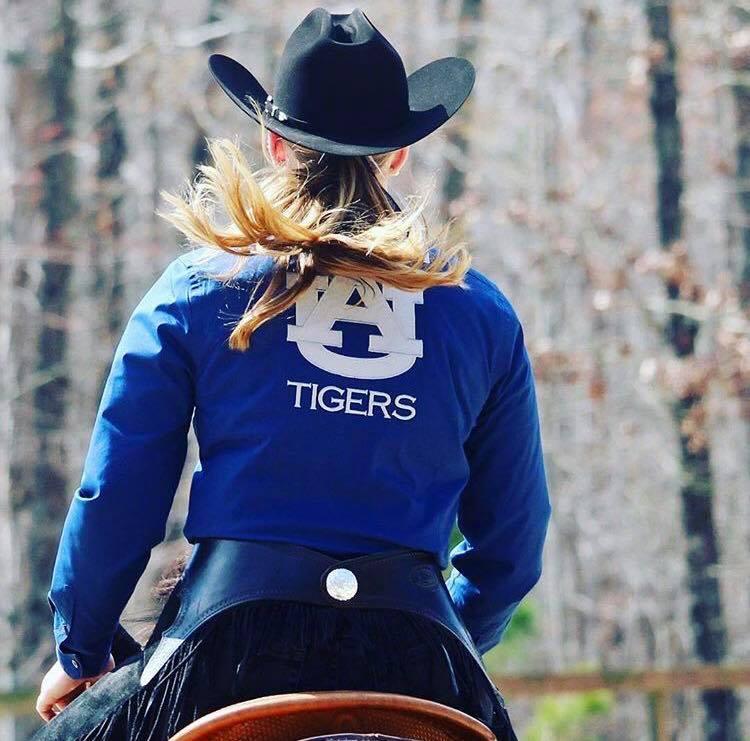

The National Collegiate Equestrian Association (NCEA), a non-profit corporation, was created as a governing body to advance the sport of equestrian. The NCEA is responsible for the development and administration of equestrian rules and guidelines.
In 1998, Equestrian was identified and adopted by the National Collegiate Athletic Association (NCAA) and the Committee on Women’s Athletics (CWA) as an emerging sport for women at the Division I and II and III levels. Currently, there are 18 Division I and four Division II programs sponsoring equestrian.
Equestrian is subject to all NCAA policies and procedures in the same manner as other sports. NCEA is committed to providing collegiate opportunities for female equestrian student-athletes to compete at the highest level, while embracing equity, diversity and promoting academic and competitive excellence.
 Competition Format: NCEA tests five riders from each team in head-to-head competitions. Five horses are selected for each event. Each rider is paired with one of the five horses in a random draw before the competition. She is able to watch the horse warm up and receives four minutes to practice on her assigned mount before competing. Riders from opposing teams compete on the same horse in the head-to-head competition. Each rider receives a score, and the rider with the highest score receives one point for her team. In NCEA competition, the level of difficulty is demonstrated by the accuracy of the pattern and how the competitor uses the horse that she draws to the best of her ability.
Competition Format: NCEA tests five riders from each team in head-to-head competitions. Five horses are selected for each event. Each rider is paired with one of the five horses in a random draw before the competition. She is able to watch the horse warm up and receives four minutes to practice on her assigned mount before competing. Riders from opposing teams compete on the same horse in the head-to-head competition. Each rider receives a score, and the rider with the highest score receives one point for her team. In NCEA competition, the level of difficulty is demonstrated by the accuracy of the pattern and how the competitor uses the horse that she draws to the best of her ability.
NCEA recognizes four competitive disciplines:
- Hunt Seat Equitation Over Fences
- Hunt Seat Equitation on the Flat
- Western Horsemanship
- Western Reining
Sports Destination Management: What is NCEA’s season?
Dr. Leah Fiorentino: The NCEA season is officially classified as a spring sport by the NCAA, which means that is when the post-season championship occurs. However, the season begins in the fall in mid-September through our national championship in mid-April.
 SDM: What kind of participation trends are you seeing in the sport? Are you seeing increased interest?
SDM: What kind of participation trends are you seeing in the sport? Are you seeing increased interest?
Fiorentino: We are currently working with over 40 schools who have expressed interest in starting a varsity team on their campus that would compete in the NCEA format, so we are optimistic about the growth of the sport.
SDM: What are the demographics of the participants?
Fiorentino: The NCAA classifies Equestrian as a women’s sport. Since we are working with the NCAA on moving the sport through the emerging sport process, all NCEA-affiliated teams are comprised of women.
SDM: Is there any geographical distribution you tend to see more?
Fiorentino: Many of our teams are in the south east/south central area of the United States. We are focused on expanding the footprint to include more schools in the west, north, and east so our current schools in those regions have more local competition opportunities.
SDM: How does the organization choose locations for its competitive events?
Fiorentino: The NCEA format is based on a head-to-head competitive meet. Similar to other NCAA sports, a team travels to a meet at another school, so there is a home school and an away school competing. Home/away competitions can be schedule by coaches or in some instances the schedules are set by conference offices.
SDM: How can a destination show interest in hosting? Is there a bid form or should they contact someone at NCEA directly?
Fiorentino: Since all in-season competition is scheduled for campus locations, the athletic departments at that school handle the management of the event. The national championship location is set for Waco, Texas, at the Extraco Center. Individuals can contact me directly if there is an interest in hosting that event. Once the sport reaches championship status, the NCAA will handle the bid process for national championship.


